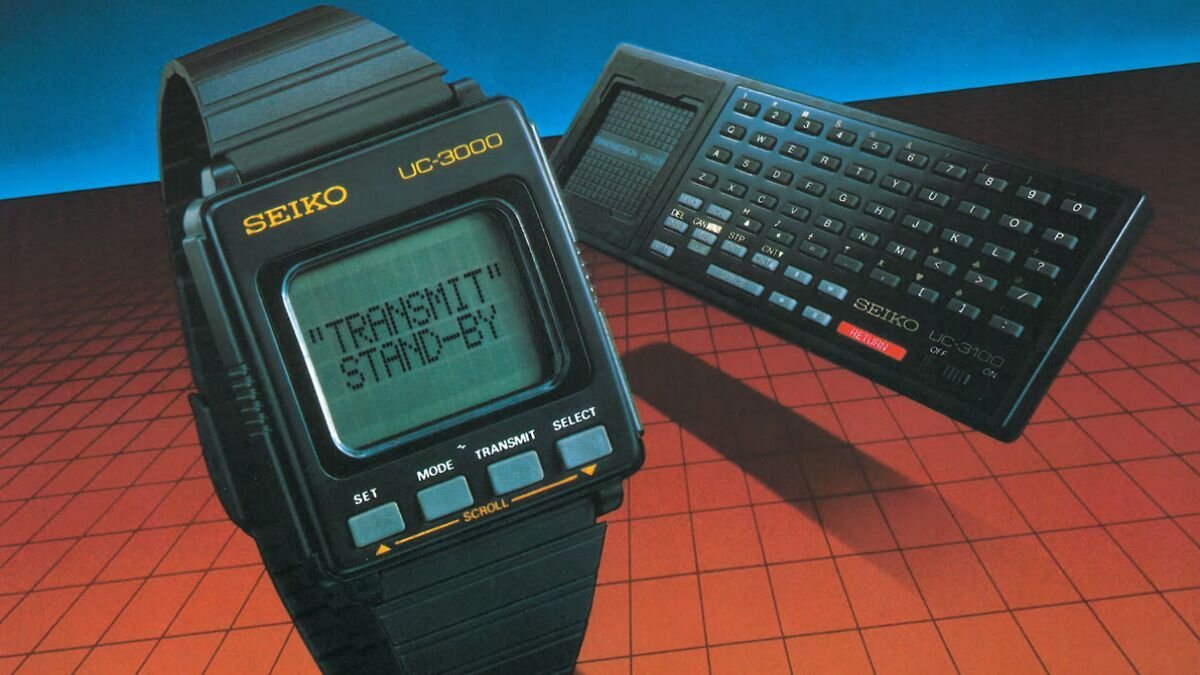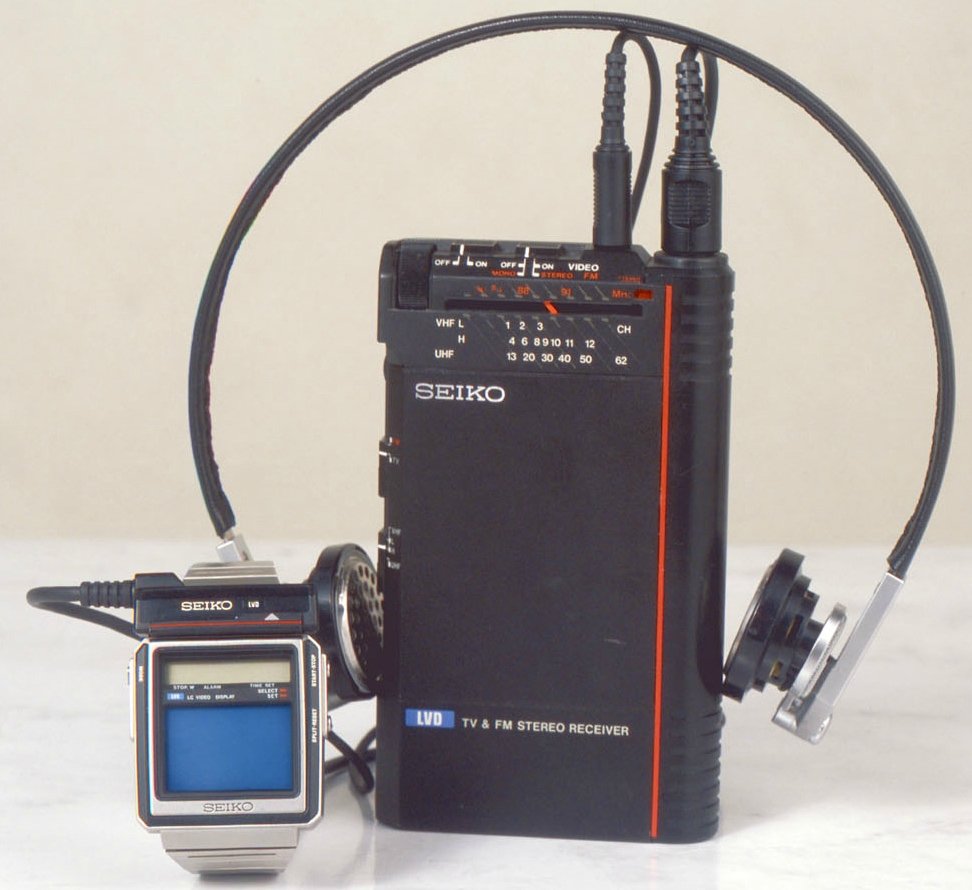SMARTWATCHES BEFORE THE SMARTWATCH - HOW JAPAN REDEFINED THE WRISTWATCH

When it comes to the prevalence of wearable technology, most would consider it to be an exclusively modern phenomenon. After all, it was only back in 2015 that the best-selling smartwatch of all time, the Apple Watch, was first launched.
But when thinking of the true definition of a smartwatch and the nature of wearable technology as a whole, it is plain to see that the roots of these seemingly hyper-modern devices go much further back. Stripped of all their ornamental trappings, smartwatches are simply wearable computers that have assumed the form of a wristwatch – and knowing this plunges one down something of a rabbit hole.
Their exact origins are not completely clear, but watches have existed in some form or another since the early 19th century. It was not until much later in the 1970s that they would become the precursors to what we now know as smartwatches. The transformation from analog timekeeper to portable computer that the watch saw during this time can be attributed to one radical new development: quartz. Without quartz-powered watches, digital electronic timekeeping would not be possible, and without that neither would smartwatches. And it was Japanese watch manufacturers that would champion this new technology and start a horological revolution that is now known as the Quartz Crisis.
The Quartz Crisis was a period of violent technological disruption that forced the entire watch industry to rethink how it operated and reconsider the true nature of timekeeping as well. Starting from the early 1970s, up until the 80s, and even today, consumer attitudes on timekeeping have changed dramatically. Mechanical wristwatches went from being seen as the best and only reliable option in wearable timekeeping to being seen, and subsequently marketed as, antiquated yet charming odes to Old World craftsmanship out of necessity to survive the Quartz Crisis.
Their position as the dependable everyday timekeeping tool of the masses was replaced and eclipsed by digital quartz watches. These new electronic timekeepers were even more reliable and accurate than their mechanical cousins, yet several times cheaper to produce, and they flourished in the 1970s up through the 1990s. And it was this combination of accuracy, reliability, and high value that enabled Japanese companies such as Casio, Citizen, and Seiko to create the wildly imaginative yet groundbreaking digital quartz watches that would eventually pave the way for the Apple Watches and Fitbits of today.
The following article will showcase and detail five important Japanese digital watches that range from historically significant innovations, to pop culture icons, to simple novel curiosities, but that all in some way or another laid the foundation for contemporary smartwatches.
Casio PRT-1GPJ “Satellite Navi” (1999)
There is no doubt that smartphones and watches have made navigation and direction finding easier than ever. After all, with apps such as Google Maps and Waze and Strava, it is no problem getting from point A to point B, even if both of those points are unfamiliar. Gone are the days of consulting a physical map on the side of the road when lost, or printing out directions from MapQuest when embarking on a first-time journey to a new destination. Thanks to a system of satellites which orbit us 24/7, we are able to access our live location almost anywhere on Earth. But it was not an overnight transition from paper maps to the mass market GPS-enabled wrist computers of today. It was a decades-long period of trial and error and incremental innovation, and one of those innovations was the Casio PRT-1GPJ, nicknamed the “Satellite Navi.”
Originally released in June 1999, the Casio Satellite Navi was the world’s first wristwatch with built-in GPS. It was the halo model of Casio’s PRO TREK line – an outdoor-focused line of rugged watches designed and made for hikers, explorers, and anyone else fond of going off the beaten path. And clad in shock-resistant plastics and rubbers, standing almost one inch tall off the wearer’s wrist, the Satellite Navi certainly looked the part.
With a full charge, the watch could last for up to 10 hours of continuous use – surprisingly respectable when compared to modern smartwatches with similar capabilities. Though, one aspect of the Satellite Navi that does not hold up too well when compared to modern standards is its monochromatic 8-bit display. On this display, it could show a live location through latitude and longitude, as well as through a four-point compass setting. The watch could also be connected to a PC to view the wearer’s journey and up to 200 landmarks noted along the way.
The Satellite Navi was able to accomplish all of this through its connection to a system of 27 American satellites – impressive for the time, but almost agricultural when compared to the hundreds of GPS satellites that currently orbit Earth today. And although the Satellite Navi’s capabilities were limited by the technological ceiling of its time, it was its spirit of visionary optimism and Casio’s relentless innovation that would prove to be truly timeless. This legacy would go on to inform the design and technology of hundreds of life-saving wearable GPS devices to come, all of which follow in the footsteps of the PRT-1GPJ.
Seiko T001 (DXA001) aka Seiko TV Watch (1982)
Today’s smartwatches are easily identifiable by their bold, bright, high resolution screens. It is through these screens that the wearer is able to access the functions that go beyond simply telling the time: instant messaging, health statistics, even media consumption such as listening to music and watching videos. In this way, smartwatches are truly more computer than wristwatch – resembling the latter only in form. But believe it or not, this was also the case for a certain Seiko watch, released in Japan almost 40 years ago in 1982 – the Seiko DXA001, otherwise known as the Seiko TV Watch.
Released one year before the original G-SHOCK, the Seiko TV Watch was literally record breaking, earning the Guinness World Record for “smallest TV set in the world” in 1984. The watch was able to receive both VHF (very high frequency) and UHF (ultra high frequency) TV channels and displayed them on a 1.25-inch black-and-white LCD screen – alongside the date and time on a smaller display above of course.
However, the watch’s hyper-modern design and headlining feature set was somewhat misleading, as it required the use of a Walkman-sized receiver that needed to be plugged into the watch in order to power it. Although to its credit, the pocket-sized receiver also allowed the watch to receive FM signals and pull double duty as a radio as well. But as seemingly bulky and troublesome as the watch is by today’s standards, back in 1982 it was a revelation. So much so, in fact, that it was none other than Agent 007’s wristwatch of choice in the 13th James Bond film Octopussy, released in 1983.
That is correct – before Daniel Craig or Pierce Brosman ever strapped on an Omega in their role as 007, the world-famous British spy was wearing a Japanese digital watch in the form of the Seiko DXA001. In Octopussy, James Bond, played by the late Roger Moore, makes use of the wrist-mounted TV as a camera monitor in the movie’s climax – though its capability and image quality is somewhat exaggerated. Nonetheless, its vision of a wearable screen that was capable of on-the-go media consumption no doubt served as an inspiration for countless devices which would eventually culminate with the high-resolution smartwatches of today.
Casio G-SHOCK DW-5000C (1983)
Ask the average person to name the first digital watch that they can think of and more than likely most would say some version of the Casio G-SHOCK – and for good reason. The G-SHOCK’s fame is second only to its reputation for toughness and reliability, as evidenced by its popularity amongst athletes, military, and other similarly demanding users around the world. After all, these are the core tenants that the watch was designed around. The first G-SHOCK, dubbed the DW-5000C, was originally released in its native Japan in 1983, but began life inside the mind of Casio engineer Kikuo Ibe two years earlier in 1981.
Ibe conceived the idea of the G-SHOCK after he accidently dropped his mechanical watch and it was “destroyed entirely.” Disheartened at the loss of his watch, which was a gift from his father, Ibe sought to create a watch that could withstand similar gravitational shocks (G-SHOCK for short) and whatever else the wearer could throw at it. When designing the watch, Ibe and his team followed a criteria they called the triple ten: it had to be able to withstand a 10 metre drop, 10 atmospheres (or 100M) of water pressure, and have a battery life of 10 years. And this is exactly what the DW-5000C did.
After 2 years of development and over 200 prototypes drop-tested out of the third-floor men’s washroom window at Casio HQ, the first G-SHOCK was released in April 1983. The DW-5000C’s groundbreaking toughness was thanks to a revolutionary hollow structure, in which the watch’s internal quartz module is suspended within the case, held in place in only a few key points. This ensures that in the event of any drop or impact, the heart of the watch never absorbs the full force of the shock. This technology would become the core of every G-SHOCK and would make the watch the blueprint for every modern smartwatch with sporting pretensions.
Citizen Multizone 7400-70015C (1993)
A minor yet undeniably convenient aspect of travelling with a smartphone or watch, besides the obvious, is never having to worry about keeping track of time zones and never having to manually adjust the date and time. Through the magic of satellite-borne cellular networks, any connected device is able to instantly and automatically find the correct local time for almost any locale on Earth. Even today’s most advanced mechanical watches with their GMT and world time complications cannot boast this capability. However, Citizen was able to accomplish exactly this back in 1993 with the world’s first multi-band radio-controlled watch – the quartz-powered The Citizen Multizone 7400-70015C.
The Citizen Multizone 7400-70015C (Multizone for short) has what can only be described as a face that only a mother could love, characterized by a large antenna coil prominently positioned right in the center of the watch’s dial. One could easily imagine this watch strapped to the wrist of a Nikola Tesla-esque mad scientist as he toils away in an old-yet-airy laboratory, surrounded by steampunk-inspired inventions. However, it is this visually dominating antenna that enables the headlining feature of the Multizone – its pioneering radio-controlled timekeeping.
In the 7 o’clock subdial of the Multizone one will notice a singular hand surrounded by six markings, three of which are “EUR,” “U.K.,” and “JPN.” These correspond to three radio towers located in Frankfurt, Germany; Anthorn, England; and Ibaraki, Japan respectively. At 2 AM on every even day, and at 4 AM on every odd day, the watch receives a radio signal from either of these three towers and adjusts the local time accordingly. “L-1” and “L-2” can be set to any time zone of the wearer’s choosing. And using the watch’s five distinct pushers, the wearer is able to navigate through all of these different functions more intuitively than one would expect.
Today, Citizen boasts an entire line of watches that are capable of radio-controlled timekeeping. And outside of the brand, any cellular-enabled smartwatch is capable of keeping track of time zones and much, much more. Moreover, they are able to do so with sleek 21st century looks – smooth, seamless blocks of machined metal with touch-sensitive surfaces and composite straps. The Multizone looks laughably clumsy in comparison, with its wild array of buttons and seemingly unfinished antenna coil. But if the Citizen looks like a crude prototype, that is because it was – it was the first watch capable of 100% accurate externally dependent timekeeping, and it did so over 20 years before the Apple Watch was a thought in anybody’s head.
Seiko Quartz Astron 35SQ (1969)
Before the smartwatch was the cell phone, before the cell phone was the quartz watch, and before the quartz watch was the Seiko Astron. Without the Astron, not only would none of the other watches on this list exist, but wearable electronic timekeeping as we know it would not be possible. Before the Astron, wristwatches were as analog and mechanical as car engines – a complex array of springs, gears, and levers. However, the inherent complexity and abundance of moving parts within a mechanical watch movement – coupled with the limits of precision machining and metallurgy of the time – meant that there was a hard limit on how accurate they could be.
Quartz timekeeping had existed since 1928, but like early computers they were massive in size, suitable for use only as laboratory clocks and reference timekeepers. Come the early 1960s, and thanks to decades of continued experimentation, quartz clocks had shrunk down enough to be used on ships as high-accuracy marine chronometers. This led many brands, including some well-known Swiss names such as Omega, Piaget, and Patek Phillipe, on a mission to create a quartz movement that was efficient, reliable, and accurate enough to put into a mass-market watch. However, it was Seiko that would bring the world’s first electronic watch to market on Christmas of 1969 in the form of the Astron.
The Seiko Astron looks nothing like the digital watches of today – and that is because it was nothing like them. For starters, though electronically powered, the Astron was technically not digital – the time was displayed on its dial through traditional hands and indices rather than through digits on a screen. But more importantly, its design and material choice was the stuff of pure opulence. At 36 mm wide and 11 mm thick, the Astron is relatively small when compared to the watches of today. However, what it might have lacked in stature it more than made up for in gravitas. The rounded cushion case, which Seiko is now so famous for, was sculpted out of solid 18K yellow gold and was fastened to the wrist on a full grain alligator leather strap – far from what one typically expects of a quartz watch. The original Astron also retailed for 450,000 yen (over $14,000 USD today) when it debuted in 1969 – the equivalent price of a mid-size sedan back then.
But this is all to say that Seiko knew just how historically important the Astron would be and wanted the design to be appropriately representative. And underneath all its luxurious ornamentation lay the true reason for the Astron’s being, the Seiko quartz caliber 35SQ. This was the most accurate wristwatch movement in the world at the time of its release, rated to a then unheard-of accuracy of +/- 5 seconds per month – compared to an accuracy of +/- 15 seconds per day of a then-contemporary mechanical watch. Seiko describes in fantastic detail how this was made possible here. It would not be an exaggeration to say that the Astron is the most important singular watch ever created, sparking a revolution in wearable technology, and shifting the global perception of timekeeping forever. As Seiko themselves so aptly put it: “It was the Astron that began the democratization of the quartz movement that would eventually bring accurate timekeeping within the reach of all.”
It was the Quartz Crisis that kickstarted a revolution in wearable technology, and looking back at these five quirky, beautiful, and undeniably innovative watches, it is evident that it was Japanese companies that led the charge. Without the ambitious ingenuity of watchmakers like Seiko, Citizen, and Casio, portable electronics would not be what they are nor where they are today. And while it is true that cellphones and smartwatches have rendered multifunction quartz watches largely obsolete, that does not mean that they do not still have a place in the world.
Aside from laying the cumulative foundations necessary for smartwatches to exist in the first place, quartz-powered watches still hold a very dear place in the hearts of collectors and enthusiasts alike. Many recall these pre-smartwatch smartwatches and ones like them with warm fondness – nostalgia for a simpler, more honest time when the world seemed bigger and more mysterious. Although primitive by modern standards, these five pioneers from the golden age of quartz live on now as charming odes to new age progress and innovation in the digital age. Smartwatches may have replaced their position on the wrist, but not in the hearts and imaginations of appreciators worldwide.
About the author
Jesse Chan is a freelance writer based in Toronto, Canada. A lifelong hobbyist and collector, Jesse is an avid appreciator of all things well-made and artful.








